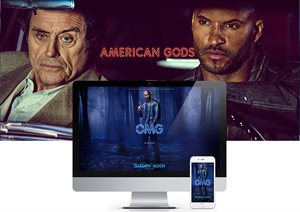A Multimedia Hub for American Gods Fans Built on Headless CMS
If you follow the web content management market at all, then you must have read a few if not a dozen articles on whether organizations should go with headless or they should stick with a  traditional Content Management System (CMS). In my opinion, there will be cases when a pure headless CMS may serve you better as long as you have the necessary skill-sets at your disposal, or a traditional CMS can provide great value when there is not necessarily added value in a headless or decoupled CMS. Knowing many companies and digital agencies are experimenting with the cloud-based solutions to see what it can do, we wanted to have a deeper understanding of the headless CMS use cases. To that point, in this article, I will dive into a project for creating a visually focused and streamlined multimedia hub for a TV show called American Gods based on the novel by celebrated fantasy fiction writer Neil Gaiman.
traditional Content Management System (CMS). In my opinion, there will be cases when a pure headless CMS may serve you better as long as you have the necessary skill-sets at your disposal, or a traditional CMS can provide great value when there is not necessarily added value in a headless or decoupled CMS. Knowing many companies and digital agencies are experimenting with the cloud-based solutions to see what it can do, we wanted to have a deeper understanding of the headless CMS use cases. To that point, in this article, I will dive into a project for creating a visually focused and streamlined multimedia hub for a TV show called American Gods based on the novel by celebrated fantasy fiction writer Neil Gaiman.
An Overview of the Project
To be able to understand the content requirements of this project, first, let’s take a closer look at what the show is about and what is it that FremantleMedia, the producer of the show, is trying to accomplish by creating a central hub for the fans of the show.
American Gods was filmed across locations in the US and Canada during 2016 and hit our screens in May 2017. The show follows the events of the award-winning novel of the same title, American Gods, by expanding the point of view to go above and beyond Shadow Moon, an ex-con who becomes a bodyguard and travelling partner to Mr. Wednesday, a conman but in reality one of the older Gods, on a cross-country mission to gather his forces in preparation to battle the new deities. Here's a brief background story by the writer of the novel:
With the plot of the show in mind, it is a no-brainer to understand how important it is to have an interactive, dynamic, and visually focused website with a mobile-first design as a fan engagement platform, where the producing company can share exclusive videos, character profiles, and interviews with the cast as well as showrunners Bryan Fuller and Michael Green, and author of the American Gods novel, Neil Gaiman.
As the content was on a timed release for each new character reveal and episode airing, the creators of the show needed a technology that would allow content to be uploaded and edited quickly and easily to keep up with the constantly-evolving nature of the site. To that point, FremantleMedia chose Kentico Cloud, a cloud-first headless CMS and digital experience platform. The entire concept of the site is based around Kentico Cloud’s modular content functionality. The functional aspect of the site was built using ASP.NET MVC hosted on Amazon EC2 instance for maximum scalability.
To build a website acting as a multimedia hub with image-moving content took only two months. As far as the types of content go, this media-rich website has so many different assets, from the five variations of video to the immersive 360 tours of the set. Not only did the team need to make sure these unique sets of visual content flow seamlessly on a single page; but they also had to pay special attention to how the site performs on mobile devices, considering the sheer volume of their audience was expected to engage with the multimedia hub on their mobile devices. To make it flow better, subtle parallax effects were also used when scrolling between “cards”, a format in which all content on the site is presented to the user.
Since the show has been known for being a visual feast throughout, the website had to live up to that so the online presence would match with the brand equity. On top of these, the frequency-modified, content-heavy nature of the site eventually drove the team to take a content-first approach to development. As a result, the content itself and its presentation could go hand in hand which made it easy to pinpoint the best-fit design without wasting time on experimenting and modifying.
A Headless CMS from a User Standpoint
To get an inside scoop, I reached out to Steve Wright, Director of Oxfordshire, England-based Syndicut, and he explained his team’s experiences with headless CMS in general and Kentico Cloud in particular throughout the project of building a website as a Multimedia Hub for American Gods.
Can you tell the audience about American Gods?
Wright: American Gods is based on the books by Neil Gaiman. The creators of the show (Fremantle Media and Amazon Prime) needed a way of introducing the characters and their backgrounds to their eager audience.
Comprised of cast interviews, character profiles, exclusive character, and episode-specific media, the site has a distinct mobile-first design. Particular care was placed on tailoring a simple yet engaging user experience.
What was the business rationale for using the Kentico Cloud product to build the website for the American Gods show?
Wright: The entire concept of the site is based on Kentico Cloud’s modular content functionality. All content on the site, from character bios to behind-the-scenes videos and trailers, is all presented to the user in a ‘card’ format. Each card has its own unique set of visual content in the form of image galleries, looping MP4s, backgrounds, and inline Youtube videos.
American Gods was our first adventure with Kentico Cloud. The site was designed to provide up-to-date news and content as new episodes became available. Using Kentico Cloud allowed content to be uploaded and edited quickly and easily, which perfectly suited the constantly-evolving nature of the site.
What was the biggest challenge you faced when building the website?
Wright: Having all of this media on a single page and expecting a large number of users to be on mobile devices, special attention had to be placed on performance to ensure the site didn't grind to a halt and worked smoothly on these lower powered devices. A lot of effort went into optimizing and lazy loading assets as well as memory management to prevent devices from crashing. To help aid the media-rich site, subtle parallax effects were also used when scrolling between cards.
Kentico Cloud is an omnichannel product. Were there any other elements of  American Gods developed with Kentico Cloud i.e. delivery to smartphones, tablets, other IoT devices?
American Gods developed with Kentico Cloud i.e. delivery to smartphones, tablets, other IoT devices?
Wright: Kentico Cloud proved beneficial from an internal standpoint. The internal teams were able to collaborate more effectively with development and design running concurrently. This more agile approach allowed Syndicut to stick to the given timeline set by the client.
How long did the project take?
Wright: Working with TV and production companies always involves a quick turnaround time and American Gods was no different. From start to finish, the site took 2 months to bring together and launch in time for the shows release date.
What kind of traffic is the American Gods website generating?
Wright: The results for American Gods are strictly confidential so, unfortunately, we’re not allowed to share them. Many of the people reading this story will likely never have used a headless CMS system before.
Any words of wisdom for those who never have used a headless CMS system before?
Wright: Moving to a cloud-based CMS has proved a success. Our words of wisdom would be to take the jump! It’s not ideal for every project out there but the benefits are never ending in some cases.
Have any future projects for Kentico Cloud in mind?
Wright: Since launching American Gods, we’ve already launched another project using Kentico Cloud. Whilst working with Little Dot Studios (A digital content studio and broadcaster based in London) we decided that Kentico Cloud would be the best solution for their company.
The site needed to highlight and focus on the video content and imagery. The Vimeo integration needed to be the main focus on every page as most projects are light on content due to confidentiality. The site had a quick turnaround time, Kentico cloud allowed both Syndicut and Little Dot Studios to work concurrently with adding the content and videos to the CMS whilst designing the site at the same time.
The modular approach of Kentico Cloud allows the production company to build pages based on the amount of content they’re allowed to show. This approach kept the time between kick off and launch to the absolute minimum. Meaning the site was designed, built and launched within 1 month.
Kentico Cloud also helped us manage the content for a Game of Thrones project we launched with Sky UK earlier this year.
My POV
While some say a headless CMS approach is a game changer approach, others believe it may seem more groundbreaking than it is. As the vendors keep debating whether it is an either-or situation, digital businesses are testing the waters with cloud-based solutions to leverage all of the traditional benefits of the cloud such as increased reliability, scalability, and flexibility in a more secure manner. Speaking to CMS-Connected, Karol Jarkovsky had stressed that Kentico’s platform is built as a native cloud solution, meaning that it provides not only all the benefits that come with the cloud technology but also the benefits that come with an API-first CMS.
To me, one of the most important advantages of a headless CMS is scalability because having the back-end and front-end separated can speed up the response time of the site by shifting display logic to the client-side and streamlining the back-end, but this also depends on the front-end implementation. It is a prominent factor, as studies have shown that if your website takes more than 4 seconds to load, your conversion rate declines by 40%.
In our conversation, Karol Jarkovsky had also explained how Kentico’s comprehensive cloud-first CMS and digital experience platform could help organizations create new content projects more frequently and quickly: “Once developers have a static prototype ready, they want to deploy it. Unlike traditional CMS, they don’t need to transfer static elements to CMS as with the Kentico Cloud. Developers take the prototype they have and replace a small fraction of static codes with codes to API that brings dynamic content to the website, then they go live immediately. It means that the platform allows them to shorten the time-to-market.”
Creating a multimedia hub with a distinct mobile-first design for the American Gods fans seems to make a great use case for a headless CMS approach, considering the constantly-evolving nature of the site.
It’s important to note that all the platforms and approaches come with their own pros and cons but, at the end of the day, it is a matter of your priorities and what you could compromise on to get those priorities done in a timely fashion.

Venus Tamturk
Venus is the Media Reporter for CMS-Connected, with one of her tasks to write thorough articles by creating the most up-to-date and engaging content using B2B digital marketing. She enjoys increasing brand equity and conversion through the strategic use of social media channels and integrated media marketing plans.